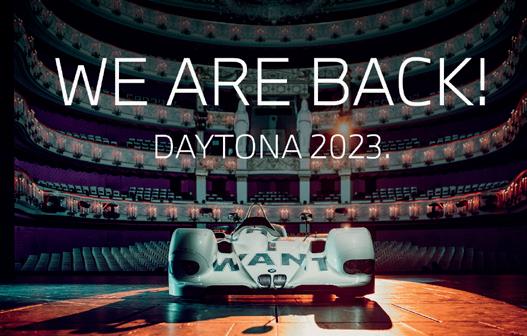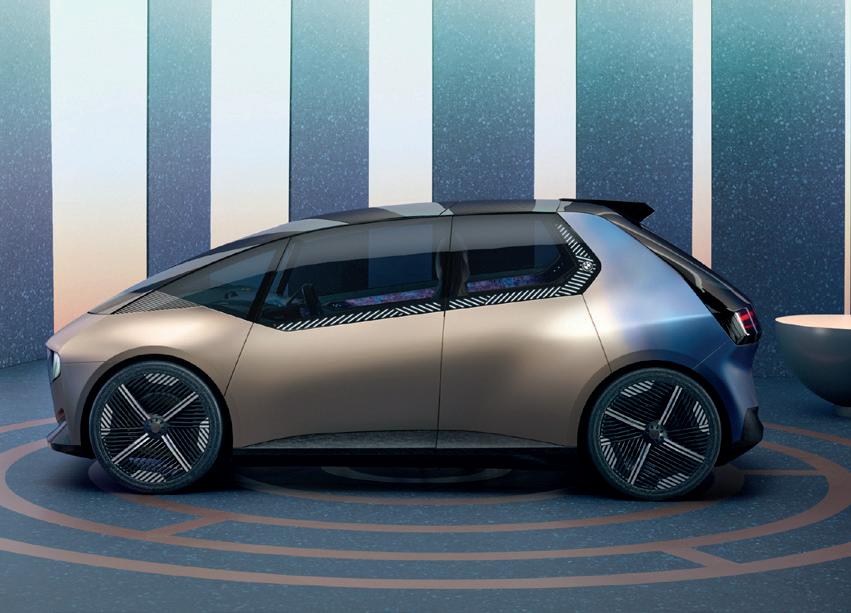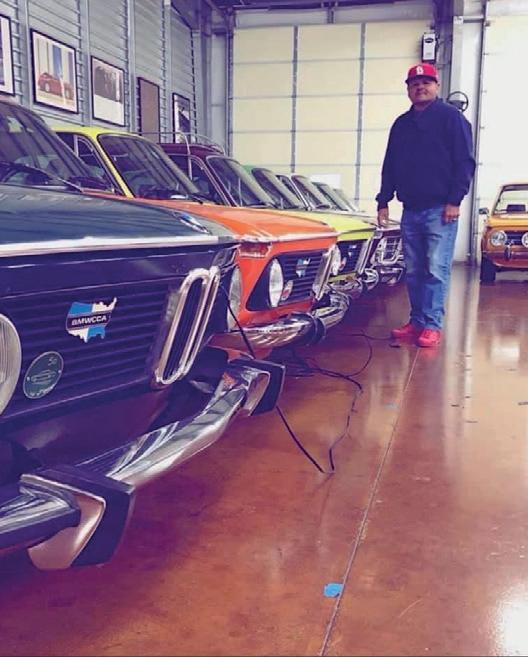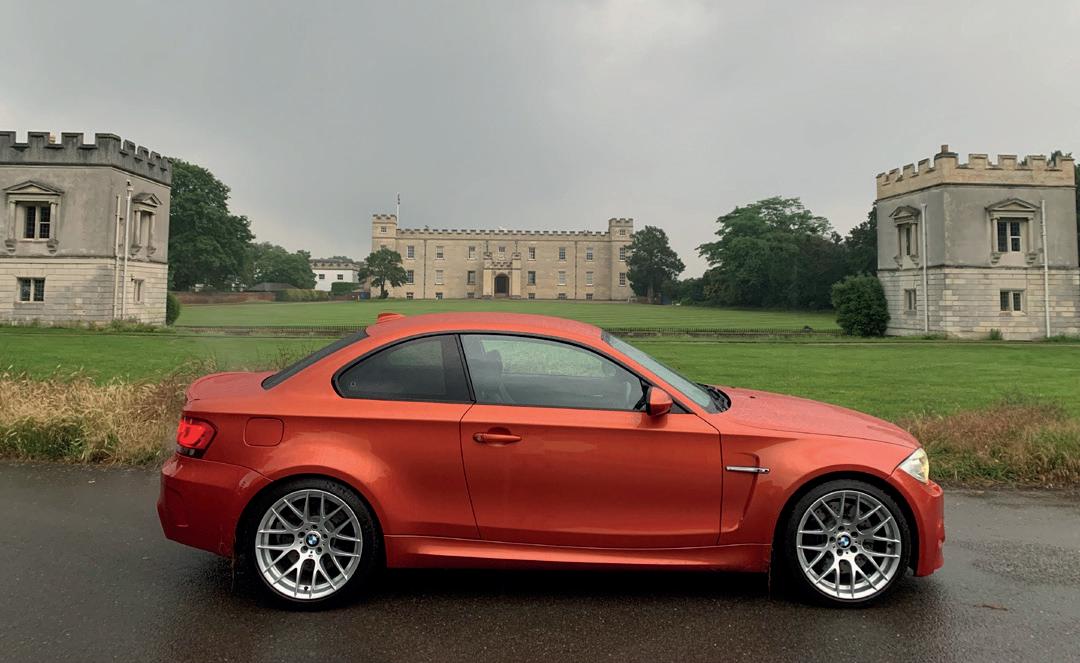
11 minute read
MLife: What does CS stand for?
LIFE What does CS stand for?
Words: Will Beaumont Photos: BMW Press
Advertisement

Some letters just scream speed. R and, especially on a motorbike, RR. There’s GT and, of course, M too. T and Ti deserve an honourable mention. S should be more exciting, but it’s been used on too many mediocre trim levels to raise any pulses on its own. With an R, a GT, a T, even an I, however, now we’re talking.
The letter C, now I don’t get that. Comfortable, casual, calm, compliant… conventional. It’s so soft, so lacking in intimidation that I am baffled as to why it’s one-half of BMW’s most aggressive badge: CS. Remember, there is currently no GTS version of the new M4… not yet anyway.
History is the reason it’s there. You know the story, but let’s go over it again quickly. Back in the 1960s, the coupé-version of the Neue Klasse was differentiated from its saloon brother by a C at the end of its name: 2000C. A more powerful version was then given an S, too. Together, CS stood for Coupé Sport. A fitting name for what was a brisk car, but one that majored on elegance rather than ballistic velocity. BMW then continued to use CS on its big coupé models, the impossibly dignified 2800 and the 3.0 CS and CSi.

It all changed for the pleasant pair of letters when BMW added an L for Leicht (light) and created one of its most famous homologation specials, the 3.0 CSL. From then on, in BMW circles, there were no three letters more important and this car gave further credibility to the previously modest CS badge.
The M635i CSi and oh-so-nearly-anM-car 850 CSi kept the reputation of the letters C and S in high esteem throughout the 80s and 90s. Then, with the best E46 M3 you could buy, the CSL title was revived. Trimmed down, lithe and with more power, the M3 CSL was, and still is, a highlight of the M3’s 35-year life span. Along with aiding in the creation of a whole new genre of vehicle, the stripped-out track day special, the CSL is responsible for the modern BMW CS models too.
Once the E46 M3 was in the autumn of its production life, BMW added an optional package, code name ZCP, that added some of the trick parts from the CSL. It didn’t include the carbon airbox or any of the engine upgrades, but the ZCP pack brought with it the CSL’s quick steering rack, its bigger brakes, the M-Track stability control function, an Alcantara steering wheel and CSL-inspired springs and 19-inch Y-spoke wheels – beautiful, but not quite as light as those on the CSL.
In Europe, cars with the ZCP option were given the title Competition Package. But here in the UK, some clever bod called it the M3 CS. For some, this was the M3 to have of the E46 range. Only those who have a phobia of automatics, though, because unlike the CSL, the CS could be equipped with a manual gearbox. Those three pedals and the quick rack combine to give the CS a character that’s not apparent in any other E46 M3. Not one from the factory, anyway.
The CS is more like an ordinary E46 M3 than a CSL, that’s for sure. It doesn’t have the same wide, stuck-to-the-floor feel of the CSL, nor the same howling motor. It’s altogether more relaxed.
It does, however, borrow a big dollop of the limited-edition car’s accuracy and poise. The different springs and livelier steering add more energy to the way the E56 M3 behaves, yet it’s always obedient.
Without the CSL’s tenacious appetite for speed, all that sharpness simply adds masses of control and confidence. The CS is forgiving when the standard soggy-by-comparison E46 M3 is a little cumbersome, and approachable when the CSL is too senior. That’s within the parameters of the E46 M3, as none of them really feel clumsy or aloof compared to many other cars. Even many other BMW M-cars.
The result is a car that feels like it’s been solely designed to put a smile on your face. Barr the induction scream of the CSL, sadly, the CS has every one of the E46 M3’s most fun components. Not the fastest ones, not the bits that will






knock seconds off its Nordschleife time like automated gears, super-sticky tyres or rock hard suspension. Instead, equipped with a manual ‘box, it has everything to encourage you to be a bit cheeky, to drive just for the sake of it.
Competition Package, as it’s called overseas, is a poor title for the E46 M3 CS. It doesn’t feel race-inspired in the slightest. Lap times are the last thing going through your mind as you’re playing, messing about and sliding around. CS makes sense, then, as a title for this M3. It’s not as physically light as a CSL, so doesn’t deserve the L, and yet it’s sort of a CSL-lite.
That is, of course, if CS does stand for Coupé Sport. As the CS name was only adopted by the UK, you won’t find any CS badges on the car and the title doesn’t have truly official status. So what it really stands for, no one knows, because twelve years later BMW reused CS on the firstgeneration M4 and the letters stood for something completely different.
Like the E46, the new CS was the second most serious model in the lineup, borrowing components from the top tier GTS. The M4 range was topped by the GTS, followed by the CS, then the Competition Package with the regular M4 at the bottom. This time, the CS’s initials stood for Competition Sport.
Why the change? Because Coupé Sport doesn’t sound like a step up from the Competition Package? Maybe. Most likely, however, is that a year after the M4 CS was launched, the M3 CS appeared. A four-door saloon, where a c for coupé wouldn’t be appropriate at all.
This new breed of CS, which in the F80 M3 range was the ultimate iteration of this super saloon, had a different goal to the E46. It seemed like the CS was designed to right some of the wrongs of the F80 and F82 M-cars. Often described as spiky and dangerous, the regular M3 and M4 weren’t as universally loved as their forebears. The CSs, with more exhaust noise (rather than the speaker assisted sound), lightweight wheels, revised suspension geometry and sticky Michelin Pilot Sport Cup 2 tyres, were more honest and the more manageable cars in the F80 and F82 range. Despite even more power than the Competition Package, the CS has 460hp, the changes allow you to use everything the 3-litre twin-turbo straight-six has to offer more of the time.
It’s amazing what the CS tweaks do to the M3 and M4’s characters. The animallike manner of the base car is manipulated into a pure and devastating pace. Rather than being unexpectedly scary, one of the loveable/off putting traits of the standard car (delete as appropriate), the CSs can frighten you with their phenomenal, unrelenting speed. They feel like they have one job to do: the raw industrial engine is there to launch your destination. You just need to keep your cool, let the slightly improved suspension and much better tyres do their job, drive with just enough respect and either CS will sing to your tune. Not literally, its gruff gravelly gurgles are not all that melodious.
The M3 and M4 CSs are impressive cars. Dependable where the originals are bad-tempered. But lurking in the back of your mind are two things. One, the CS was expensive when it was new. Both
were around £20,000 more than the cost of a Competition Package version. The second is that how much taming of the F80/82’s wild side is down to just the tyres. Would simply adding a set of Cup 2s on an M4 give you that same confidence? Some new rubber is a much more affordable solution than buying an entire CS.
This new breed of CS couldn’t be faulted dynamically, but the cynical amongst us were worried for the future of M cars if the CS brand was here to stay. In many ways, the CSs were always what the M3 and M4 should have been out of the box. I like the M3 and M4, even the early ones, but I will admit they weren’t good enough. How they developed and the subsequent iterations proved this. Would this template be replicated in the future, would we be sold subpar standard M-cars to make expensive sub-brand CS models seem worth it?
It’s impossible to be so sceptical when faced with an M2. Whether it’s a regular version, the Competition or the CS. Not that there’s any need to be. The trajectory of the CS’s standing skyrockets thanks to the version made from the smallest M-car. It’s essentially the same recipe as the F80 M3 CS as it became the top of the M2 range with a few lightweight parts, more power and stickier tyres. Chassis changes were more comprehensive for the M2, however, rather than mild geometry alterations the small CS was awarded the fully adaptive system from the bigger Ms. Plus, like the E46, this car was available as a manual.
The beauty of the M2 has always been how simple it is to drive, how forgiving its chassis is, how easy it is to place its small footprint on the road, how rapidly it can make you giggle. The M2 Competition, the twin-turbo version, was more businesslike in its approach with more power and tougher looks than the original. Still, none of the M2’s playful demeanour was eroded.
The CS, with more technology, more grip, even more power, still can’t take away the M2’s jovial nature. Yes, all the fun happens at more serious speeds, but the CS is even more biddable than the softer M2s, and that means you can be even more juvenile if you wish. It will perform neatly if you want. On track, all the elements that make the M2 CS so willingly hilarious – its easy-to-tap-into agility, that almost telepathic control you have – make it a cinch to drive fast. It’s a deeply versatile machine, then, if what you’re looking for is a car for speed and fun. Beyond that, I can’t help you – I never once tried the rear seats, measured the boot size or counted the cup holders. It’s really not that kind of car. As frivolous as the M2 CS might be, and it really is only in the best way possible, it disappears into sensible rational territory when compared with the latest CS, the M5. This new car is the most comprehensive CS job yet. The M5’s 4-litre V8 is taken from 616bhp to 626bhp, making it the most powerful M car to ever go on sale. It’s 70kg lighter than an M5 Competition, and it has re-tuned suspension and Pirelli P Zero Corsa tyres.
It features far more cosmetic changes than any other CS, too. Not only does it get gold wheels but the grille surrounds, side trims and badges have been made to match the rims. It’s available in just two colours: Deep Green and Brands Hatch Grey. Both are matte (or Frozen in BMW parlance) but the latter tint can be selected as gloss. Then there are the front lights, they shine yellow (only when stationary, though) to mimic the lamps on the front of endurance race cars.
That’s before we get onto the interior, which features two front bucket seats and, instead of a rear bench, two more race-style buckets in the back. It’s mad, unapologetically bonkers. And, because of that, truly and utterly brilliant.
I am yet to drive an M5 CS. But whatever it’s like from behind the wheel won’t detract from one of its best attributes, that it exists at all. That in this day and age of planet-saving rhetoric and electric low-impact cars, BMW, which spends so much time and effort to look responsible, can create an obscenely fast saloon car with just four bucket seats and a big dollop of stuff-you attitude, is a huge achievement. It could drive like a tired 525ix with worn-out bushes and mismatched tyres and I’d still love it. But I know it won’t. It could drive exactly like an ordinary M5, which is spectacular anyway, and it would be worth the extra money. The brashness of those race-car inspired lights, when the M5 has no connection to any sort of GT car, make it worth the extra £38,000 over an ordinary M5.
It doesn’t really matter what the letters CS have stood for over the past two decades because those two letters have represented such a diverse selection of cars. CS could just as easily stand for Completely Serious on the F80 and F82 as they could Comically Silly on the M5 CS. It doesn’t matter there isn’t total consistency across the board, though, because every CS has its place in the range. Whether it’s to exaggerate the car’s innate character, like the M2 CS, smooth out any faults, like the F8X CSs, create a machine of pure joy like the E46 or make us proud we live in a world where such ridiculousness can exist, like the M5.













